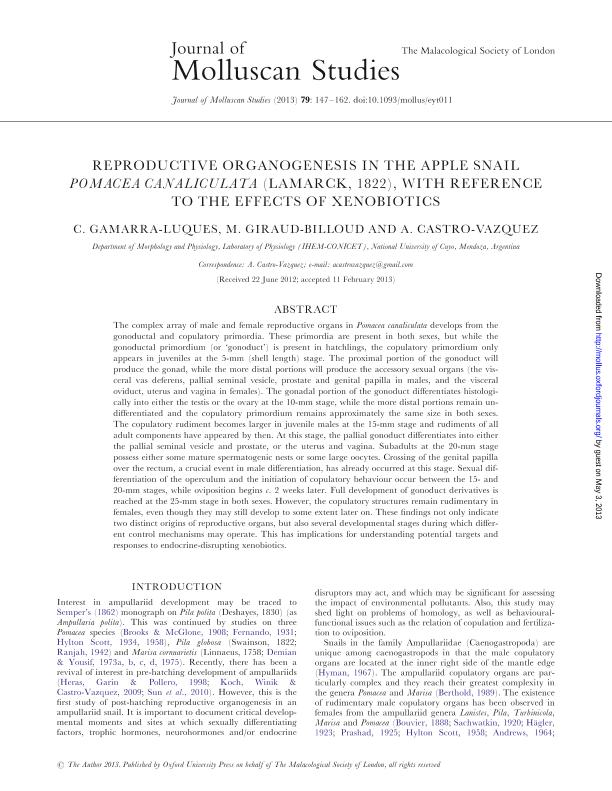Artículo
Reproductive organogenesis in the apple snail Pomacea Canaliculata (Lamarck, 1822), with reference to the effects of xenobiotics
Fecha de publicación:
03/2013
Editorial:
Oxford University Press
Revista:
Journal Of Molluscan Studies
ISSN:
0260-1230
e-ISSN:
1464-3766
Idioma:
Inglés
Tipo de recurso:
Artículo publicado
Clasificación temática:
Resumen
The complex array of male and female reproductive organs in Pomacea canaliculata develops from the gonoductal and copulatory primordia. These primordia are present in both sexes, but while the gonoductal primordium (or 'gonoduct') is present in hatchlings, the copulatory primordium only appears in juveniles at the 5-mm (shell length) stage. The proximal portion of the gonoduct will produce the gonad, while the more distal portions will produce the accessory sexual organs (the visceral vas deferens, pallial seminal vesicle, prostate and genital papilla in males, and the visceral oviduct, uterus and vagina in females). The gonadal portion of the gonoduct differentiates histologically into either the testis or the ovary at the 10-mm stage, while the more distal portions remain undifferentiated and the copulatory primordium remains approximately the same size in both sexes.The copulatory rudiment becomes larger in juvenile males at the 15-mm stage and rudiments of all adult components have appeared by then. At this stage, the pallial gonoduct differentiates into either the pallial seminal vesicle and prostate, or the uterus and vagina. Subadults at the 20-mm stage possess either some mature spermatogenic nests or some large oocytes. Crossing of the genital papilla over the rectum, a crucial event in male differentiation, has already occurred at this stage. Sexual differentiation of the operculum and the initiation of copulatory behaviour occur between the 15- and 20-mm stages, while oviposition begins c. 2 weeks later. Full development of gonoduct derivatives is reached at the 25-mm stage in both sexes. However, the copulatory structures remain rudimentary in females, even though they may still develop to some extent later on. These findings not only indicate two distinct origins of reproductive organs, but also several developmental stages during which different control mechanisms may operate. This has implications for understanding potential targets and responses to endocrine-disrupting xenobiotics.
Palabras clave:
Xenobiotics
,
Apple Snails
Archivos asociados
Licencia
Identificadores
Colecciones
Articulos(IHEM)
Articulos de INST. HISTOLOGIA Y EMBRIOLOGIA DE MEND DR.M.BURGOS
Articulos de INST. HISTOLOGIA Y EMBRIOLOGIA DE MEND DR.M.BURGOS
Citación
Gamarra Luques, Carlos Diego; Giraud Billoud, Maximiliano German; Castro Vazquez, Alfredo Juan; Reproductive organogenesis in the apple snail Pomacea Canaliculata (Lamarck, 1822), with reference to the effects of xenobiotics; Oxford University Press; Journal Of Molluscan Studies; 79; 2; 3-2013; 147-162
Compartir




